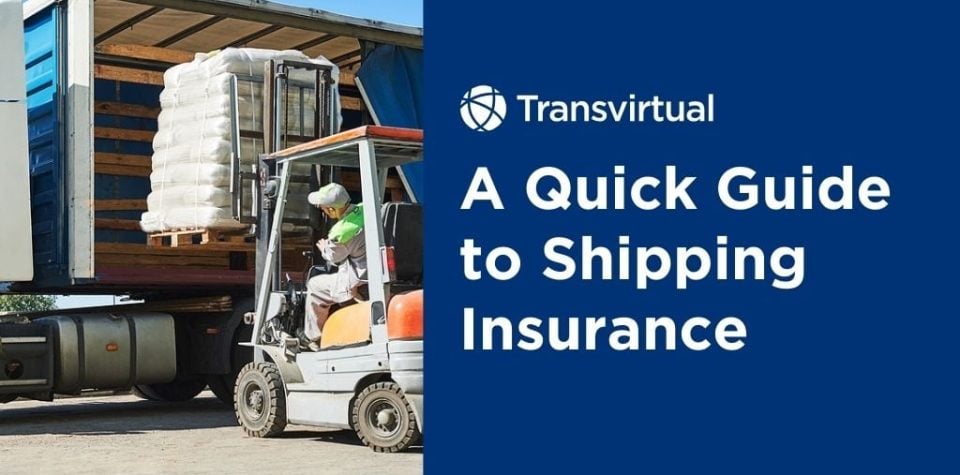Shipping is a risky business. It relies on many moving parts and coordinating with different parties, leaving a lot of room for mistakes. The potential cost of goods being lost, stolen, or damaged can be a major source of stress for businesses, with their finances taking a direct hit. Taking out shipping insurance is a way of protecting yourself against financial risks. Obtaining additional insurance can provide extra protection and peace of mind during transit, particularly for higher-value or delicate items.
This article takes you through the basics of shipping insurance and explains both what it is, why it’s important, and when / if it is a good idea for your business.
What is Shipping Insurance?
Shipping insurance is pretty much what it sounds like: a shipping / transportation business makes an agreement with an insurance provider in which the business will be fairly compensated. Shipping insurance cover entails protection against delivery delays, damage, and loss of items during transit. In return for this guarantee, you would pay a regular premium to the insurer.
Why is Shipping Insurance Important?
It’s vital to protect your business from potential losses and hardships. Depending on the types of goods you transport and their value. Replacing or reimbursing other parties for damaged, lost or stolen goods can be a large financial drain on your business.
A good insurance policy can help to alleviate that potential drain by covering a portion of the risk involved in transportation, giving you greater control over your operations. Shipping insurance is crucial in protecting against lost packages, and it’s important to adhere to specific filing deadlines for insurance claims depending on the shipping service used.
Benefits of Shipping Insurance
Shipping insurance offers a multitude of benefits for eCommerce businesses, providing a safety net against various risks. One of the primary advantages is protection against loss or damage to goods during transit. Whether it’s due to theft, improper handling, or delivery delays, having insurance coverage ensures that your business won’t bear the financial burden alone.
Moreover, shipping insurance provides financial security for exporters, especially when complications arise during delivery. Unforeseen circumstances such as natural disasters, labor strikes, or adverse weather conditions can disrupt the shipping process. By purchasing shipping insurance, businesses can safeguard themselves against these unpredictable events.
Another significant benefit is the ability to maintain customer loyalty and trust. Ensuring that packages are delivered on time and in good condition is crucial for customer satisfaction. Shipping insurance helps businesses uphold their commitment to quality service, thereby fostering long-term customer relationships.
What Shipping Insurance Cover Options are Available?
Every insurance provider will have different policies under which different things are covered, so it’s important to check the specifics on your own. However, there are four basic types of shipping insurance that you need to be aware of:
1. Parcel Shipping Insurance
Parcel shipping insurance is crucial as it covers issues such as delivery delays and damage to items during transit.
Parcel shipping insurance covers delivery delays, damage to items, and payment collection failures.
2. Carrier Insurance
This is insurance that is provided by a carrier as part of a delivery service.
3. Self Insurance
This often comes in the form of a ‘customer guarantee’ and involves assuming responsibility for reimbursing or replacing goods for the buyer if they are lost, damaged or stolen in transit.
4. Third Party Shipping Insurance
Third party insurance is the most common type of insurance. It involves signing a contract with a third party insurance company that isn’t connected to either you or the buyer.
Shipping Insurance Costs
The cost of shipping insurance can vary widely based on several factors, including the carrier, service level, and the declared value of the goods being shipped. Major carriers like USPS, UPS, and FedEx offer shipping insurance as an additional service, with rates typically determined by the value of the items. For instance, the cost to insure a package with a declared value of $100 might be different from insuring one valued at $1,000.
Third-party shipping insurance providers also play a significant role in the market, often offering competitive rates and additional benefits. These providers can be particularly advantageous for businesses looking for a single point of contact for all insurance-related issues and advanced tracking software. The cost of shipping insurance can range from a few dollars for lower-value items to several hundred dollars for high-value shipments, depending on the level of coverage required.
When considering shipping insurance costs, it’s essential to weigh the potential financial impact of lost or damaged goods against the insurance premiums. This cost-benefit analysis can help businesses make informed decisions about the level of coverage they need.
When Do You Need Shipping Insurance?
Insurance needs to be cost effective for your business in order to justify taking out a policy. This usually involves some variety of cost / benefit analysis where you weigh up the cost of the premium against the potential value the policy could provide you. During this process it is important to estimate the value of the products you transport, and the likelihood of them being lost, damaged, or stolen whilst in transit.
The shipping insurance cost is influenced by several factors, including the shipping carrier, service type, and the value of the shipment.
Although we’re always inclined to suggest going on the safe side, there are a range of factors that influence if / when shipping insurance is a good idea for your business.
1. You regularly transport fragile goods
Let’s face it: some goods are simply far more likely than others to be damaged during transit, and if you transport these goods regularly then you are likely to benefit from the protection and peace of mind that shipping insurance can provide. Understanding what insurance cover entails is crucial, as it protects against damage during transit, including delivery delays, damage, and loss of items. If these items are damaged, then you can recoup the costs from your insurance provider rather than the damages costing your business.
In this sense, insuring a shipment of rubber ducks is far less crucial than insuring a shipment of champagne flutes, since it’s far harder to damage or break a rubber duck.
2. You regularly transport goods with a high declared value
The value of the goods that you transport is another key factor in determining whether or not shipping insurance is a good choice. The burden on your business that is created by lower cost goods being damaged or lost is far lower in the case of cheaper goods, whereas the transportation of higher value goods can present more of a financial risk. To determine whether insurance is a good financial decision, it is often a good idea to weigh the cost of replacing goods out of pocket against the cost of your premiums, along with how likely it is that the items will need to be compensated for. Expensive and fragile goods carry a higher risk associated with them, and companies that transport them may have a greater need for insurance. Obtaining additional insurance for high-value shipments can provide extra protection and peace of mind during transit. Of course, the definition of expensive depends on the size of your business, which is why thorough analysis is needed.
3. You transport goods at risk of theft
For precious, priceless, or high-risk goods, such as jewellery, art, or pharmaceuticals, the risk of theft whilst in transit is higher. If you transport goods that are likely at risk of theft, then insurance can be a good way to recover costs afterwards. The equation will likely be the same as with goods of high value: what is the potential benefit provided by the policy vs. the cost of taking it out?
4. To guarantee customer satisfaction
At the end of the day, the most important part of the transportation industry is maintaining the trust and relationships that you have with your customers, and a loyal customer is often worth a great deal to a business.
Filing a Shipping Insurance Claim
Filing a shipping insurance claim can be a straightforward process if you have all the necessary documentation and follow the required steps. To initiate a claim, businesses typically need to provide proof of shipping, proof of value, and documentation of the damage or loss. This might include tracking numbers, receipts, and photos of the damaged items.
The process for filing a claim can vary depending on the carrier. Some carriers, like USPS, UPS, and FedEx, allow claims to be filed online or by phone, making it convenient for businesses to report issues. It’s crucial to keep accurate records of all shipments, including packaging materials, to ensure that claims can be processed quickly and efficiently.
Timely filing is also important. Most carriers have specific time frames within which claims must be submitted, so it’s essential to act promptly. By maintaining thorough documentation and understanding the claims process, businesses can navigate the insurance claim process with ease and recover their losses more efficiently.
Shipping Insurance and Technology
Technology has changed the way businesses purchase and manage shipping insurance. Many carriers and third-party providers now offer online platforms that simplify the process of buying insurance and tracking shipments. These platforms provide a user-friendly interface where businesses can easily select the level of coverage they need and monitor their packages in real-time.
Additionally, some insurance providers offer APIs and integrations with eCommerce platforms, allowing businesses to automate the insurance process. This integration can streamline operations, reduce manual errors, and save time. For example, an eCommerce platform might automatically purchase shipping insurance for every order above a certain value, ensuring consistent coverage without additional effort.
Technology has also improved the claims process. Many carriers now offer online claims filing and tracking, making it easier for businesses to report issues and monitor the status of their claims. By leveraging these technological advancements, businesses can enhance their shipping insurance processes, reduce costs, and ultimately improve customer satisfaction.
Final tips on Shipping Insurance and Filing an Insurance Claim
Of course, no two insurance policies are the same, and we can’t tell you whether or not it is going to be the right move for your business.
What we do recommend is that you thoroughly look into whatever policy you’re thinking of and make sure that the goods you transport and methods of transportation are securely covered.
Many businesses can be left in the lurch after finding out that they missed something important in the fine print, and it’s always a good idea to get sound legal advice before signing up.
And that’s our rundown! If you have questions about any aspect of the shipping process, don’t hesitate to get in touch, or read some more of our articles to know more about different aspects of the shipping process.



